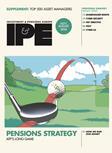We recommend that real assets amount to 65% of the strategic portfolio leaving only 35% to nominal bonds.
That is due to the fact that the typical pension fund has a long-term horizon and that its main objective is to maximise the purchasing power of the funds at the time of the repayment to the pension clients. Recent studies including our own research concludes that historically, stocks have not only significantly outperformed bonds but even been less risky in terms of inflation adjusted real returns of holding periods of five -10 years or more.
As a direct consequence of the euro we have changed the benchmark portfolio by moving 10 percentage points from Danish to international equities, thereby increasing the ratio between international and Danish equities from 1:1 to 3:1. Before the euro Danish pension funds were only allowed to invest 20% of the total portfolio in foreign currency denominated-assets on an unhedged basis. Now this basic rule of congruence has been changed permitting an additional share of up to 50% to be invested in euro-denominated assets. This leaves more room for international equities - an opportunity we have exploited fully in order to im-prove the risk/return profile of the overall equity portfolio and increase liquidity.
An additional reason to reduce the benchmark weighting of Danish equities is that the euro has reinforced a trend among investors to move from a country approach to a sector approach. This trend might hurt Danish stocks because they are generally small compared to the average size in their European sectors. Therefore a rather small number of Danish stocks will qualify for the most commonly used European sector indices. That is why within our Danish equity portfolio we prefer large cap to mid/small caps.
Concerning nominal bonds, 25% of the total portfolio is allocated to Danish bonds and 10% to international bonds. This mix of approximately 2/3rds Danish and 1/3rd international bonds is rather unusual compared to the sector average of 95% and 5%, respectively. Our rationale for assigning a relatively high weighting to international bonds is that our research has concluded, that a certain share of international bonds on a currency hedged basis has a very positive impact on the risk/return profile of the overall portfolio.
Our tactical deviations from the benchmark portfolio are based on our expectations on a three month horizon. We fear that disappointing reported earnings for 1998 and subdued earnings expectations for 1999 might cause a set back in the stock markets. As we do not expect any significant changes in bond yields we have switched 5 percentage points from equities to bonds.
Relative to the benchmark we prefer European stocks to North American ones. US stocks seem ex-pensive judged from multiples whereas in Europe in the wake of the euro there is increased scope for restructuring and mergers and acquisitions. In an economic environment with bleak growth prospects, we prefer defensive growth sectors such as technology, pharmaceuticals and telecommunication while cyclicals like basic materials and capital goods are underweighted.
Looking one year ahead we are more positive. We think it will be possible to contain the Brazilian crisis and we hold a Chinese devaluation pretty unlikely. We believe that Japan gradually will move out of recession and in 2000 will be able to report positive growth figures. We do not see the UK moving into recession.
Probably the US economy will be able to avoid a hard landing and instead turn into a sustainable growth path. After a set-back in 1999 we expect Euroland growth to return to a level of 2% in 2000. At the same time we do not see any inflation pressures building up anywhere.
Against this background we expect the stock market to rebound during the second half of 1999 as this scenario becomes more obvious. Bond yields will probably remain fairly stable 'setting the stage' for stocks to outperform bonds on a one-year horizon.
Benc Lystbaek is vice president, international fixed income strategy at Danske Capital Management in Lyngby












No comments yet